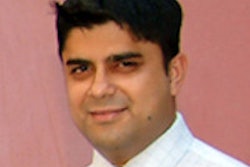Residents aren't marching in lockstep with the new American Board of Radiology (ABR) policy when it comes to study time for the new core exam, according to results of a survey of residents and faculty at a Pennsylvania hospital that were presented at the 2013 RSNA meeting.
In fact, the survey found that most residents and faculty were opposed to the policy from the Association of Program Directors in Radiology (APDR) of no protected exam time for the core exam -- and many believe that the time-honored practice of "board frenzy" will continue.
"There was almost 100% agreement that there should be no call for third-year residents before the core exam," and most survey respondents said that third-year residents need six to eight weeks of dedicated study time before the core exam, said Dr. Brian J. Clark, a resident at Pennsylvania Hospital in Philadelphia.
Effect of new core exam
The survey of the academically affiliated radiology residency program was undertaken to evaluate the effect of the new radiology core exam on the residents and faculty, he said.
The core exam is part of ABR's initial certification process to determine whether trainees have acquired the requisite knowledge of diagnostic and interventional radiology, radiation oncology, and physics needed to practice competently.
ABR last year implemented a long-planned test overhaul that includes a core exam taken after 36 months of diagnostic radiology training that replaces the written exam. A "certifying" exam, which replaces the old oral exam, is taken 15 months after completion of the four-year residency. The first new core exam was administered last October.
The 28-question survey, which was distributed in the first quarter of 2013, relied on a five-point Likert scale that gauged response to statements about the new exam (possible responses ranged from "strongly agree," which was rated 5, to "strongly disagree," which was rated 1). The goal was to tease out the views of residents and faculty on various aspects of the new core exam structure.
In all, 60% of the radiology residents and 35% of program faculty responded to the survey, for an overall response rate of 48% (n = 19). The residents came from all four years of training, mostly ages 30 to 39 years, and the faculty had been in practice for less than 10 years to more than 20 years, encompassing a wide range of ages.
Where the groups differed
Just two questions showed significant differences in response between the radiology residents and faculty, Clark said.
When asked if residents were likely to pursue research during the fourth year considering the earlier timing of the core exam, most residents agreed that they were likely to pursue research during fourth-year training (mean = 4, p = 0.01), while most faculty were undecided.
The residents disagreed (mean = 2.1, p = 0.04) that the new exam format would affect fellowship choice, while faculty were undecided.
Where they agreed
The remaining responses in the survey showed no significant differences between residents and faculty.
When asked how familiar they were with the new ABR certification process, 89% of respondents agreed or strongly agreed that they were familiar with the process. Fully 95% were able to identify 2013 as the first year of the core exam; however, only 68% were able to identify 2015 as the first year of the new certifying exam, "suggesting that they are not as familiar as they may have let on," Clark said.
When asked how the core exam would test fundamental radiology knowledge, 74% were undecided or agreed that the core exam would be an adequate measure, but 79% were undecided or disagreed that the core exam would better prepare residents for future practice.
'Board frenzy' not going away?
As many residents know, the new test regime eliminates dedicated study time for the core exam, as ABR considers its content fundamental and believes that the skills it tests are the byproduct of dedicated service in the department.
"Full-time participation by the residents in clinical and didactic activities must occur at all levels of training, including the final year of residency," state Accreditation Council for Graduate Medical Education (ACGME) program requirements.
But residents and faculty alike maintain that "board frenzy," the traditional cram period before the boards when residents have traditionally been unavailable to perform call and clinical duties, won't simply disappear because the exam structure has changed, according to the survey results.
In fact, 94% responded that board frenzy would simply shift from the fourth year to the end of the third year, according to Clark.
Furthermore, they believe that programs should accommodate their need to study. Eighty percent agreed or strongly agreed that third-year residents should have protected study time. Most (71%) further agreed that six to eight weeks of protected time would be appropriate, according to Clark. Nearly 100% thought that residents should be relieved of call while studying for the core exam. But this view wasn't quite unanimous.
"We did notice we had one outlier, and on review of the data this did come from a faculty member," Clark said.
Knowledge of the history behind the elimination of dedicated study time was a bit fuzzy, as only 13% of respondents were familiar with the APDR's 2003 ad hoc subcommittee decision to require full participation during all four years -- and program directors' lead role in alleviating board frenzy, Clark said.
"However, when presented with the APDR recommendations, 65% disagreed or strongly disagreed with the APDR position of no time off from clinical duties before the core exam," he said.
Not surprisingly, Clark said, more than three-fourths of respondents agreed or strongly agreed that fourth-year opportunities to pursue subspecialization are important, and 76% thought that four to 12 weeks should be an appropriate length of time for those pursuits.
What programs can do to prepare
Overall, the results of the small survey suggest that programs should prepare for a shift in board frenzy from the fourth to the third year -- and programs should not expect it simply to go away, Clark said.
"Programs can provide third-year residents with six to eight weeks of protected study time while protecting coverage needs," he said. "This protected study time could be no call responsibilities, or even something such as two hours of protected time during the day."
Similarly, programs could also provide fourth-year residents with four to 12 weeks of subspecialty training while managing department needs, he said.
"I think it's important ... to provide first- and second-year residents with opportunities to work with senior residents, who are a valuable source of information and learning, while the fourth-year residents are in their subspecialty training," Clark said.



















